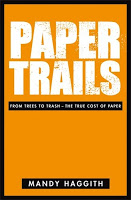This post was originallay posted on Eco-Libris blog on July 21st.
Our book this week on Monday’s green books will take you on a trail that we find one of the most interesting and significant ones in our life: the paper trail.
Our book for today is:
Paper Trails: From Trees to Trash – The True Cost of Paper
Author: Mandy Haggith
Mandy Haggith is a freelance writer, researcher and activist. She has spent the past decade campaigning for the world’s forests, including lobbying at the United Nations, working as a consultant for Greenpeace and WWF and writing articles for Pulp and Paper International and Resurgence magazine.
Publisher: Virgin Books
Published on: July 3, 2008
What it is about (from the publisher’s website): Paper charts the course of our lives, from the medical sheets in maternity wards to our death certificates. We write on it, package things in it, use it as currency and blow our noses on it. Yet our dependence on this seemingly ‘green’ product is damaging our planet and creating mountains of unnecessary waste. Join Mandy Haggith on a journey to the heart of the global paper industry, travelling from the pristine forests and managed plantations of Canada, Russia and Indonesia to the pulp mills and paper factories of China and Britain, and the end users in businesses, governments, schools and homes throughout the world.
Pursuing the paper trail from forest to landfill, she uncovers the origins, multiple uses and disposal of this everyday product and gives a fascinating new perspective on the paper industry’s dirtiest secrets, from environmental devastation to human rights abuses. You’ll discover the truth about the paper we use every day and the simple, practical steps you can take to minimise your own paper trail.
Why you should get it: Mandy Haggith took on herself a very important quest: connecting the dots. She wants to get people to better understand the connection between the paper we use and its origins – forests, many of them ancient and endangered ones.
In a way, our perception of paper today is very similar to the perception of cigarettes 30-40 years ago, when people didn’t know the consequences of smoking and saw it as a habit and natural part of their life. Hence, I see Hagith like the people who made the connection between cigarettes and cancer publicly known.
It’s not that we don’t know that paper come from trees. That’s not the problem. The problem is that many don’t have the full picture in front of them and that’s where Haggith’s book tries to fill in the void, providing readers with ALL the information about the way the paper do before it gets to your printer or the copy machine at the office.
I believe the importance of the book stems from three main factors:
- Her research is not based only on reading books at the library and sitting in front of the computer, but mainly on the journeys to forests all over the world, from China and Russia to Canada and Indonesia. I think that her research and activism capabilities create the perfect match for such a mission.
- It brings many facts and helps to clarify misconceptions and false perceptions people and businesses have which influence the way they think and act. She explained one example to the Independent lately: “No one likes to think of trees being felled, but many of us have a cosy image in our heads that it all comes from recycling or “sustainable” woodlands growing in neat rows, perhaps somewhere in Sweden. It’s a myth. Globally, 70 per cent of the 335 million tons of paper the world uses each year comes from natural, un-farmed sources. In Canada, the UK’s biggest source of pulp, 90 per cent of its output comes directly from its ancient forests.”
- Haggith not only present the problem, but also solutions, from reducing the usage of paper as whole to increasing the usage of recycled paper. And the bottom line is optimistic – we can change our habits and get over the long addiction to virgin paper.
In Eco-Libris we deal with these issues on daily basis in our fight to make reading more sustainable, and therefore I think it’s great to have a book such as this one that can become an important tool in the long fight to reduce impacts of paper production and make sure that we can enjoy the advantages of paper without destroying our forests.
If you’re looking for other interesting green books, you are invited to check out our green books page on our website’s green resources section.



Gustavion
I’ll definitely check it out.
One way we can reduce paper production is by unsubscribing ourselves from postal junk mail — it’s a huge waste. http://www.simplestop.net will take care of it for you, and plant 5 tree when you sign up.
LB in SD
Also, check out ProQuo.com to end postal junk mail…
shredding San Antonio
It is nice that such a book has been published so that we will get to understand better the “paper we use and its origins – forests, many of them ancient and endangered ones”.